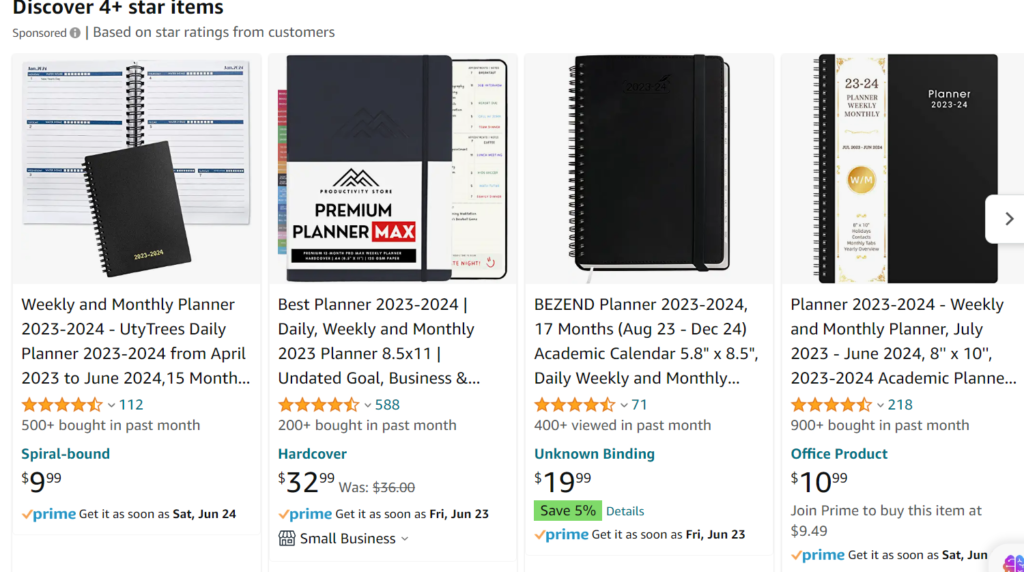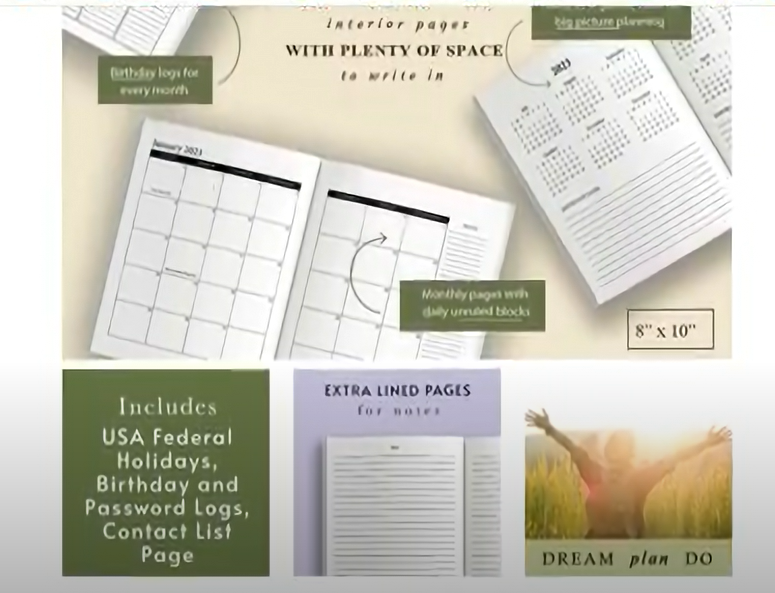If you’ve been pouring your heart and soul into publishing your first low-content books on Amazon and you’re still waiting for that first sweet sale, it’s completely natural to feel frustrated. It’s tempting to throw in the towel and resign yourself to the idea that low-content publishing just isn’t for you. But before you make any rash decisions, hold up!
In this video I’ll take you through the nitty-gritty of the self-publishing process and help you pinpoint a few crucial points where things might be veering off course. With the right adjustments you can put yourself on the path to those much-desired sales.
You’ll learn how to analyze four main areas of your publishing process to make sure you’re doing everything in your power to achieve success. Ready to get started? Let’s dive in.
You can watch the video below or read on for the main points.
(This post contains affiliate links, which means—at zero cost to you—I will earn a small commission if you click through and make a purchase. Thank you for your support!)
Before we start dissecting the areas that might be hindering your books sales, let’s address two important questions:
- Have you given it enough time (typically one to four weeks)?
- Do you have realistic expectations for your book sales?
Remember, not every book will be a bestseller. Especially when you’re new to the process, you may publish several books before you see your first sale. Even then, some books may only sell a copy or two a month. That’s okay! The 80/20 principle applies here, as it does in many areas of life and business. That means that about 80% of your sales will come from approximately 20% of your books. Keep this in mind as you start analyzing your process.
The 4 Assessment Areas
When trying to figure out why your books aren’t selling, there are four areas to assess systematically: research, design, optimization, and promotion.
Let’s look at each one in more detail.
Research
Most low-content publishers find research to be the most boring part of the whole process, but there’s no way around it. You have to do it. Successful low-content book publishing relies on solid research, which can be boiled down into five main considerations:
1. Did I validate the idea properly?
Validation means seeing if your idea has enough potential demand in the market to justify creating a product.
Have you:
- checked to see if there’s an audience who might be interested in your book?
- found evidence that similar products have been successful?
If you’re unsure how to validate your idea, check out my video, How to Validate Your Low-Content Book Idea Using Amazon, to guide you through the process. Understanding this step is crucial to ensuring you’re not investing your time and resources into a project without the potential for return.
2. Is there a paying market?
Knowing there’s an interest in your idea is a start, but it’s also important to know if there’s a paying market. This means that the people who are interested in your type of product are also willing and able to pay for it. To help understand this, tools like Amazon’s Best Sellers Rank (BSR) can provide you with useful data.
Simply type your book idea into the search bar and look at the results on the first page. If most of those books have a BSR of around 100,000 or less, that means that these books are selling fairly regularly.

3. Is the market too competitive?
It’s great to find a market with a lot of interest, but if it’s oversaturated with high-quality competitors your book might struggle to stand out. When conducting your research, seeing a lot of well-established, high-quality books with many 5-star reviews could indicate a highly competitive market.
That’s not to say you should shy away from competition altogether; in many cases, competition signifies demand. However, it might mean you need to work harder to differentiate your book and capture your audience’s attention.

4. Have I targeted a clear audience?
Your audience is not “everyone.” A common mistake is choosing a category that’s too broad. For instance, “daily planners for women” might sound like a clear target audience, but it’s still incredibly vague. Women of what age? What are their specific interests? What’s their design sensibility?
By refining your target audience you can create a product that directly addresses the unique needs and preferences of a specific group of people. Using the example above, you could focus on daily planners for working mothers, college students, or fitness enthusiasts, just to name a few. The more specific you can get, the better you can tailor your book to your audience’s needs.
5. Have I chosen relevant, low-competition keywords and categories?
Last but not least, keywords and categories can make or break your book’s visibility on Amazon. Relevant, low-competition keywords can help your book show up in searches, making it easier for your target audience to find you.
Incorporate these keywords into your book’s title, description, and backend keyword slots. Similarly, choose categories that accurately represent your book and aren’t already saturated with countless other offerings. Proper keyword and category selection increases your book’s chances of getting discovered by the right audience.
The research phase may seem daunting, but it’s a crucial aspect of publishing that, if done right, sets a solid foundation for your book’s success.
Design
The design of your low-content book is critical, as it is often the first aspect potential customers notice. Here are some essential points to consider when analyzing your book’s design:
1. Is it too generic?
Designing for everyone can often mean designing for no one. If your book’s design is too generic, it might lack the unique appeal to draw in a specific audience. To avoid this, you must tailor your book’s design to your target audience’s preferences, needs, and desires that you identified during your research phase. Think about their tastes, what appeals to them, and what design elements would speak to their interests or needs.
2. Does it stand out among competitors?
In a sea of books, you need to ensure yours doesn’t just blend in. Look at your competition. Does your book stand out or does it get lost among similar-looking designs?
Aim to create a design that makes a potential buyer pause while scrolling and take a closer look at your book. Don’t just copy what everyone else is doing, find ways to differentiate your book while maintaining its relevance to your target audience.
3. Is it formatted correctly?
Correct formatting is crucial. It can be incredibly frustrating for a reader to struggle with off-centered content or type that’s too small. Not only does improper formatting detract from the user experience, but it can also make your book look unprofessional.
Ensure your content is centered, your type is readable, and your formatting is clean and consistent throughout the book.
4. Have you used high-quality fonts and graphics?
The quality of your fonts and graphics can significantly impact your book’s overall aesthetic and appeal. Low-quality fonts and graphics can make your book look amateurish and unappealing.
I recommend using a resource like Creative Fabrica for high-quality, unique fonts and graphics. You can check out my review of Creative Fabrica here.
5. Are you a competent designer?
Honest self-assessment is key. If design isn’t your strength, it may be worth investing in a professional designer or spending some time improving your skills. Seek feedback, preferably from those within your target audience or from other experienced designers. They can provide you with valuable insights and point out potential areas for improvement that you might not see.
Remember, your book’s design is the first impression potential buyers will have of your product. It’s worth investing time and resources to ensure that this impression is a positive one. Good design not only increases your book’s appeal but can also significantly influence its success.
For more, check out my video, The Top 5 Book Cover Design Mistakes That Are Killing Your Sales.

Optimization
Optimization is the key to ensuring that your book is discoverable and appealing to potential buyers. To get this aspect right, consider the following questions:
1. Have I maximized my title information and keyword slots with low-competition keywords?
The inclusion of relevant, low-competition keywords in your title and keyword slots can significantly boost your book’s visibility on Amazon’s search engine. This process is a delicate balancing act—you want to select keywords that accurately represent your book but that aren’t so popular that your book will be buried under a sea of competitors. Use your research to identify these keywords and make sure they’re integrated naturally into your title and metadata.
2. On my book’s detail page, is the description compelling, free from spelling or grammatical errors, and properly formatted?
Your book description is often the final factor that convinces a customer to make a purchase. It should be compelling, offering a clear and enticing summary of what your book provides. Furthermore, it must be free from spelling or grammatical errors; these can greatly undermine your credibility. Lastly, ensure your description is formatted properly, making it easy to read and engaging for potential customers.
3. Have I used A+ Content to allow customers to see more of my book and showcase my quality interior?
Amazon’s A+ Content feature allows you to add enhanced content, such as more images, comparison charts, and more text placements, to your product description. This tool provides an excellent opportunity to showcase your book’s quality interior and convince potential customers of its value.
Not sure how to make the most of this feature? Check out my video, 5 Ways to Use KDP’s A+ Content To Help Your Low-Content Books Stand Out From The Crowd.

4. Have I priced my book competitively?
Pricing can significantly impact your book’s marketability. If it’s priced too high, potential customers may be deterred; if it’s too low, they may question its quality. Look at comparable books in your category to gauge a competitive price range. Remember, your price should not only reflect the value of your book but also what your target audience is willing to pay.
Remember, optimization is all about increasing your book’s discoverability and appeal. By considering these points, you’re positioning your book to attract more potential customers and ultimately drive more sales.
Promotion
Once you’ve crafted a well-researched, beautifully designed, and properly optimized book, it’s time to put it in the spotlight through strategic promotion. Here’s are some questions to help you determine if your promotion strategy could use a few tweaks to get those sales flowing:
1. Are my ads optimized and effective?
If your promotional strategy includes ads, make sure they’re optimized and working effectively for you. This means targeting the right audience, using compelling copy and visuals, and regularly monitoring your ad performance so you can make any necessary adjustments.
It’s important to remember, however, that paid ads should be the final step. They are not a magic bullet and can’t compensate for shortcomings in other areas. If your book doesn’t cater to a paying market, has a poor design, a weak description, or is overpriced, ads alone won’t make it sell. Ensure all other factors mentioned above are addressed before you invest in advertising or you’ll end up wasting your money.
If you’d like to learn more about using Amazon ads in your promotion strategy, check out my interview with one of my star Low-Content Profits Academy students, Jenny Hansen Lane.
2. Am I building an email list?
Building an email list allows you to engage directly with potential customers who are interested in your work. Offering a freebie is a common and effective strategy to attract subscribers.
Once you’ve built a list, you can promote new books, request reviews, and keep your audience engaged with relevant content. This direct line of communication can be a powerful tool for boosting your sales.
No email list yet? No problem. Check out my video, How to Build An Email List From Scratch (and for free!), to help you get started.
3. Am I leveraging my existing following?
If you already have a following, whether on social media, a blog, or any other platform, make sure you’re leveraging this audience to promote your book. Your followers already appreciate your content, so they’re more likely to be interested in your book.
4. Am I seeking and utilizing feedback?
If you’ve done everything on this list and still aren’t seeing sales, it might be time to seek external feedback. Sometimes we’re blind to our own shortcomings. You may think your designs are appealing, but others might not agree.
Don’t hesitate to ask for feedback—my Facebook group is a great place for this. Use this feedback to refine your work and improve your sales strategy.
Finally, remember that persistence is often the key to success in self-publishing. It’s not uncommon for authors to publish several books before seeing their first sale. Consider the story of Kim George, one of my star Low-Content Profits Academy students. Kim published 30 books before making a sale and now makes over $10k a month!
It’s a process that requires patience, learning, and continual effort, so give yourself some grace. You’re learning a new skill, and that takes time. Keep creating, keep refining, and keep promoting. The sales will follow.
If you want to learn how to publish other types of low-content books like journals and planners, download my free guide, 3 Steps to Publishing Your First Low-Content Book in Less Than a Day.
For additional help, join my free Facebook Group, Low-Content Profits.
